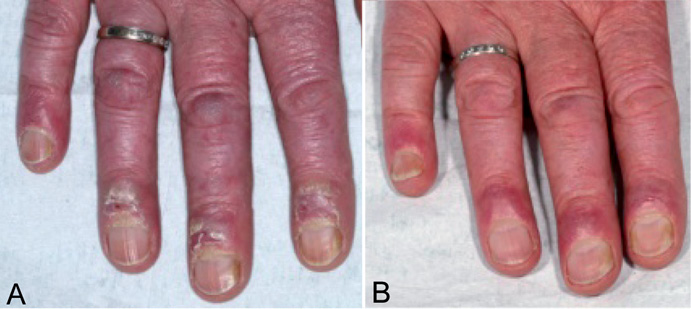Christine Dahl, Claus Johansen, Knud Kragballe and Anne Braae Olesen
Department of Dermatology, Aarhus University Hospital, Denmark, P.P. Ørumgade 11, DK-8000 Aarhus C, Denmark. E-mail: anneolse@rm.dk
Accepted July 23, 2012.
Discoid lupus erythematosus (DLE) is a common manifestation of chronic cutaneous lupus erythematosus (CCLE). Although there is evidence of beneficial effects of topical and systemic glucocorticoids, retinoid and chloroquine (1), there is a subgroup of patients for whom adequate disease control cannot be achieved and therefore there is an ongoing need for new treatment options.
A patient with severe CCLE with DLE and overlap to chilblain lupus refractory to all offered treatments was treated with ustekinumab, a human monoclonal antibody registered for treatment of psoriasis, with a maximum effect after 24 weeks of treatment (2). By binding to the p40 subunit of interleukin (IL)-12 and IL-23, it inhibits IL interaction with T-cell receptors. IL-23 plays a role in the activation of Th17 cells, which are important in the inflammatory process (3).
Case report
A 79-year-old woman presented with persistent CCLE for more than 30 years. The diagnosis of CCLE was made from her clinical appearance, negative serology and histopathological findings. Clinically, she had severe erythema, cutaneous atrophy, hyperpigmentation, scarring and telangiectasias in her face. There was scarring alopecia and erythema of her scalp. There were purple erythema, scales and ulcerations on her fingertips, and similar lesions on her toes. The patient had had no positive anti-DNA-antibodies or signs of antiphospholipid syndrome or progression to systemic disease.
Several treatment regimens were tried over the years, including topical and systemic glucocorticoids, hydroxychloroquine, azathioprine, thalidomide, methotrexate, topical calcineurin inhibitors, high-dose intravenous immunoglobulin, and combinations of these.
None of the treatments had significant effects, and a number of adverse effects were observed. As a consequence, experimental treatment with ustekinumab was started in 2011.
Prior to treatment 3 biopsies were taken; two from lesional skin on her left eyebrow and left fourth finger, and one from non-lesional skin on her upper left arm. RNA from the biopsies was isolated and the mRNA expression of p40 was analysed by quantitative PCR, as previously described (4). Increased p40 mRNA expression was demonstrated in the biopsies from lesional skin compared with non-lesional skin, and we therefore initiated the treatment after the patient’s acceptance. Blood tests excluded contraindicating diseases.
A 45 mg dose of ustekinumab was given subcutaneously at 0, 4, 16 and 34 weeks. No adverse effects were observed. The severity of symptoms was evaluated according to the Cutaneous Disease Area and Severity Index (CLASI) scoring system (5). The CLASI analyses the activity of the disease on the basis of erythema and scaling, and damage from the disease due to dyspigmentation, scarring and alopecia (6). Furthermore, a visual analogue scale (VAS) was used to evaluate pain and the impact of the disease on the patient.
Prior to treatment, the disease activity score was 23, the damage score was 19 and the VAS score was 10. After 34 weeks the disease activity score decreased to 14, the damage score was unchanged and the VAS score was 5. Objectively, the erythema on the patient’s face, scalp and fingers were improved and the ulcers on her fingertips were healed (Fig. 1). The erythema on her toes was unchanged. The patient reported feeling better than she had for many years.

Fig. 1. Response to ustekinumab on the fingers of the right hand. (A) Before and (B) after 34 weeks of treatment.
Discussion
Previous studies have shown elevated IL-12 and -17 (7) and p40 subunit expression in patients with systemic lupus erythematosus (SLE) at levels correlating with disease severity (8). In theory, this overexpression of p40 could be a target for treatment in patients with CCLE. Two recent case reports have also reported marked improvement in skin lesions in a patient with subacute cutaneous lupus erythematosus (9) and in a patient with psoriasis and hypertrophic discoid lupus erythematosus (10).
In our case we observed a considerable effect on disease activity after 34 weeks of treatment with ustekinumab. This suggests that patients with CCLE with elevated levels of p40 in skin lesions may benefit from this treatment. However, further studies of the role of ustekinumab in the treatment of patients with CCLE are warranted.
AcknowledgementS
We thank Edmund Kandborg and Mads Rasmussen for preparation of photographs of the patient (Fig. 1).
The authors declare no conflicts of interest.
References
